Queen Arabesque Pleco (Hypancistrus sp. (L260)) are beautiful bottom-dwelling freshwater fish that you can have in your aquarium. They will bring both beauty and functionality to the tank. This fish will constantly search in the tank for any excess food which will result in keeping your tank healthy. They’re easy to care for and relatively smaller compared to other plecos. L260 Pleco are also very calm and sociable fish that can live in any community tank.
Here in this article, you’ll learn the correct care guidelines for Queen Arabesque Pleco and all other information you might need.
Species Profile & Overview
The Queen Arabesque Pleco ( L260 Pleco ) is, by far, one of the most beautiful members of the Loricariidae family (plecos) native to Rio Tapajós in Para, Brazil. These fish share the same body shape as other members of the family but develop unique colors and patterns that sets them apart.
Not only do they add beauty to your tank, but also add functionality. This and the fact that they don’t grow to large makes them an ideal choice for most aquarium setups.
Queen Arabesque Pleco lives in rivers and creeks loaded with live plants, driftwood, and rocks with sand and muddy substrate. They are active during the night and will constantly forge around for plant matter, small crustaceans, and any other available food.
Caring for L260 Pleco can be a rewarding and easy experience when tank conditions are in their favor. They make a great tank mate for most fish in a community tank.
Appearance
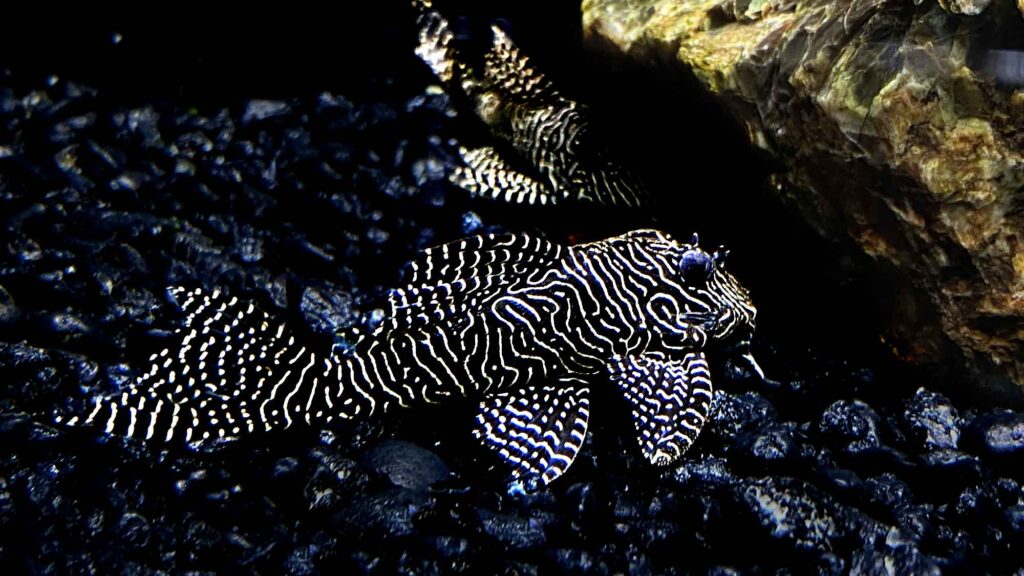
The appearance of the Queen Arabesque Pleco is the main reason most people get these fish. They have bold patterns and colors that make them stand out in the crowd.
Queen Arabesque Pleco has thin strips that are black and white in color. The patterns cover the entire back of the body and head. Their fins also have these patterns but the belly is usually yellowish without any pattern. When fish are under stress they tend to lose their coloration so its important to set up your tank properly (more on this in Tank Setup section of this article)
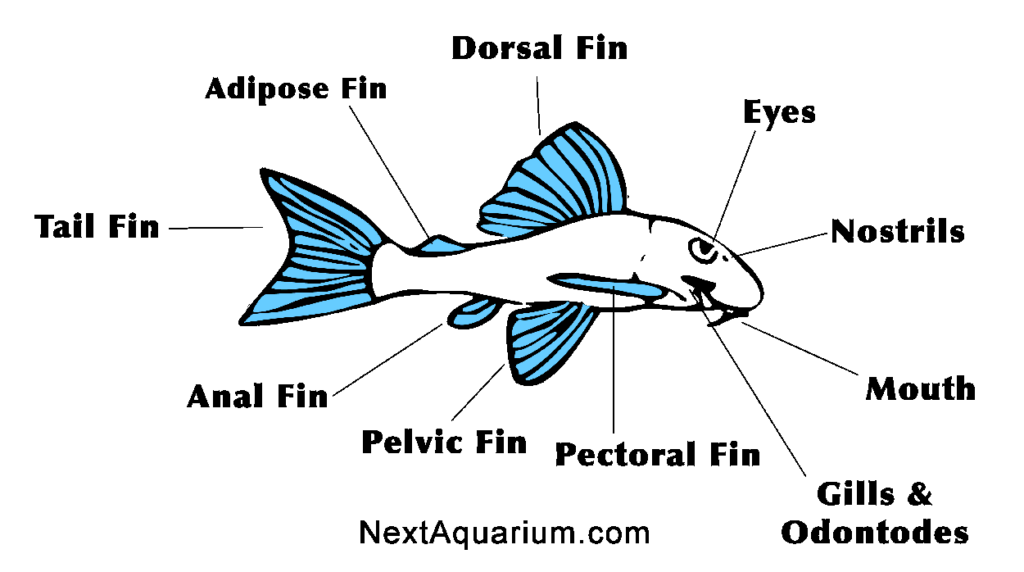
Fins have bolder stripes and patterns with the same color as the rest of the body. These stripes are imperfect and might slightly look different from fish to fish. The tail fin has a “C” shape design while the rest of the fins are more like triangles.
This fish does not have scales, they are covered with tough bone plates on their back that act as scales. Unlike their back, they have a soft belly that has thin and fragile skin.
Adult Size
The average Queen Arabesque Pleco size is 3.5 – 4 inches. Males tend to get slightly bigger and bulkier compared to females.
When you provide them with a proper care and diet, these fish will grow faster. However, they are still very slow-growing fish and will take years for them to reach their max size.
Lifespan
L260 Pleco lifespan is about 8-12 years. This means they will outlive most of their tank mates and you will need to commit to them for a long time.
Stable water conditions and regular maintenance will help this fish to reach its max expected life.
Behavior and Temperament
L260 Pleco mostly stays at the bottom and does not pay any attention to other fish swimming above. They will stay in hiding during the day and come out at night to search for food.
However, under the right conditions, this fish will also come out during the day. They mostly come out when they feel safe so if you don’t have aggressive large fish and if you throw some food you might see them start to swim around looking for the food.
Female plecos are not territorial or aggressive compared to males. If you have more than one male in your tank you might see some aggressive behavior between them. Males will fight over caves and real estate in the tank.
In order to prevent aggression among males, you will need to provide them with a tank that has a larger bottom area or just move some of the males to another tank. Providing them with lots of hiding spots and a cave for each male is another way to prevent aggression.
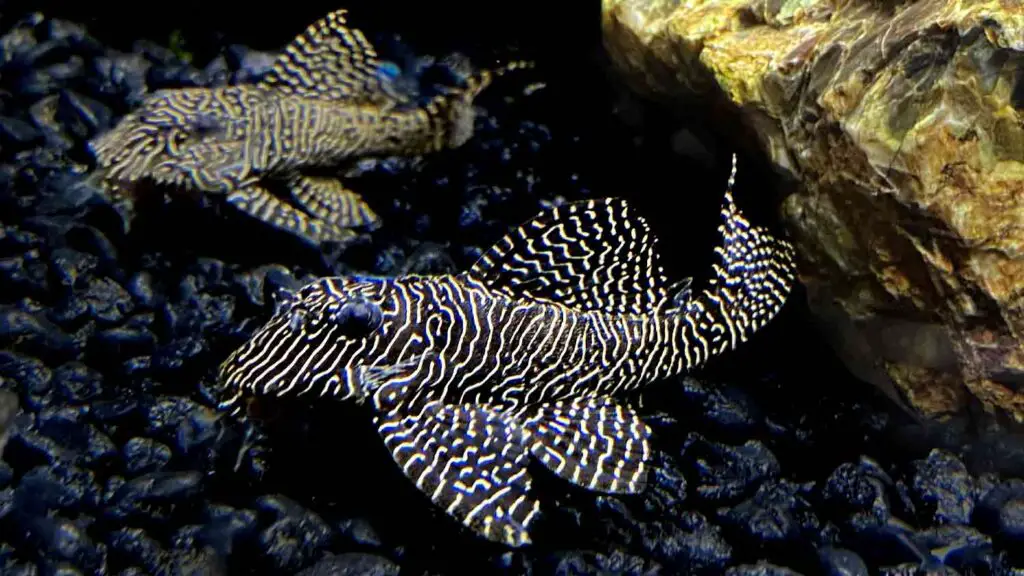
Queen Arabesque Pleco Care
Queen Arabesque Pleco care is not exceptionally difficult. Even beginner aquarium owners can keep them in their tanks.
That said, keeping this fish healthy needs special consideration. They have unique care needs and a special diet you will need to know.
Follow the suggestions below to provide the best possible habitat for your Queen Arabesque Pleco.
Tank Size
The minimum tank size for a single Queen Arabesque Pleco is 30 Gallons. These fish are one of the smaller plecos, which makes it possible for aquarists to keep them in this size of a tank. That said, it is always good to have the largest tank that you can house.
That said, more than one L260 Plecos will need a much larger tank. These bottom-dwellers need more floor space so the tank’s gallons are not always the best way to see how many plecos you can house.
To give your Queen Arabesque Pleco more floor space, if possible, choose a tank that has a wider base. Then, simply add a lot of slates and tiles to the tank to create even more floor space. Your plecos can swim over and under these slates and tiles to hide and take refuge. This will calm the fish down and they will feel safe.
Tank Setup
In your aquarium, you will need to pay attention to a few items so you can create a natural habitat for Queen Arabesque Pleco. These bottom-dweller fish are shy and prefer to hide under decoration.
The Queen Arabesque Pleco needs a lot of hiding spots in the tank. You can solve this by adding lots of driftwood and rocks to your tank. You will also need to add pleco caves in your tank so they can have a safe place to rest during the day. Natural decorations will also help you keep your tank parameters stable.
The L260 Pleco spends the majority of its time at the bottom of the tank. Sharp substrates might injure their soft belly, so softer substrates are highly recommended for this fish. Bigger but round substrates like smaller size pea gravers are also a good option to use. Another type of substrate that you can use is planted tank substrate. Planted substrates are a great option if you are planning to keep plecos and plants in your tank.
We also recommend including live plants in your aquarium. Live plants are required for a healthy environment and can expel the tank of harmful substances. Your fish will also have plenty of natural hiding spots among the plants. Use floating plants or any other type of live aquarium plant to improve the appearance and water quality of your tank.
Water Parameters
The Queen Arabesque Pleco comes from relatively fast-moving rivers of South America. The water is always warm and well oxygenated, and TDS is very low at all times. This means you will also need to create a similar environment in your aquarium. Depending on the size of your tank and the number of fish you are keeping, you might need to do more water changes to keep these fish healthy. When enough food is available, these guys will produce significant waste which means you will need to do more maintenance. Below are the tank parameters you can keep L260 Plecos in:
- Temperature: 74 – 84 Degrees Fahrenheit
- PH: 6 – 7.5
- TDS: 60 – 120 PPM
Regular water changes are very important to the health of this fish. They love clean waters that are well oxygenated. Water current is also another important topic to think about. These fish are coming from slightly fast-moving streams. This means you will need to place a powerhead in the tank to create a steady current in the tank.
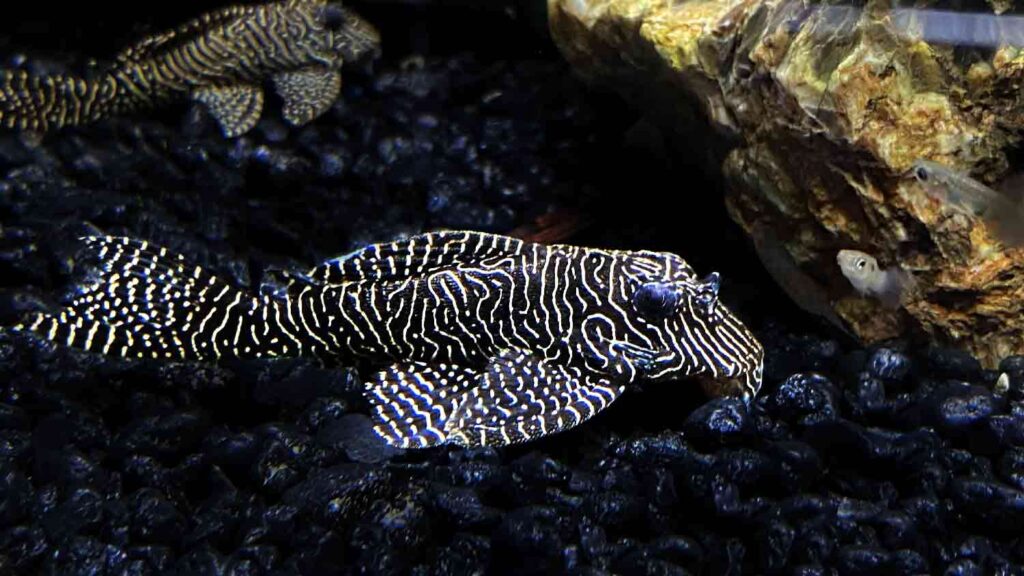
Lighting
When the aquarium setup is done properly, Queen Arabesque Pleco can adapt to any lighting conditions. However they prefer low light levels and strong lights might increase their stress levels. Ideally, it is best to select your light in accordance with the kinds of plants you are keeping in the tank.
Filter System
Due to the high waste production of Queen Arabesque Pleco, they require a powerful filter. If your tank’s filtration system cannot keep up with waste production, your fish will suffer and possibly become ill. This will have a direct impact on the lifespan of your fish.
Common Diseases and Prevention
While some fish have their own species-specific diseases, there are no known diseases for Queen Arabesque Pleco species. That being said, these fish are vulnerable to all known aquarium diseases. Your aquarium is a tiny ecosystem and diseases will easily and quickly transfer from fish to fish.
Most diseases are directly introduced to your tank by newly added fish, plants, or invertebrates. Poor maintenance will also cause bacterial or fungal infections. These are the main reasons aquarium fish get sick. In order to prevent them, you should never add fish or plants to your tank without properly quarantining them. Regular tank maintenance is also super important. Never let any uneaten food stay in the tank for long periods as it will start to rot and increase the risks of bacterial or fungal infection.
Diet and Feeding Requirements
Queen Arabesque Pleco are carnivores (meat-eaters) fish that will mainly eat high protein meaty foods only. However, they will also consume low quantities of algae, plant matter, fresh vegetables, and other plant-based foods if mixed with meat. There will be times that you might see your L260 Pleco chowing down on algae. This shouldn’t lead you to believe that you can feed these fish with algae-based foods.
Live food is an ideal way of feeding your fish. If you can source live food you should always feed them live as the main source of food. You can try feeding bloodworms, brine shrimp, daphnia, tubifex worm, and any other small live food you have.
There are multiple commercially produced dry foods available for bottom-dweller fish. Some of these foods are very high quality while some might not have all the ingredients your fish needs. Regardless, you will need to purchase a few different types of them to feed an ideal diet for your Queen Arabesque Pleco. High-protein pellets or fish flakes mixed with a low amount of plant-based foods are an ideal combination to feed.
These fish have a diverse diet in nature and will need a similar diet in captivity as well. Most fish foods available in the market only have a few of the ingredients plecos eat in nature. So you will need to buy a few different types of sinking food to create a balanced diet for your Queen Arabesque Pleco. This includes dry pallets and frozen foods; however, they should only receive live or frozen foods 2 – 3 times per week.

Breeding Queen Arabesque Pleco
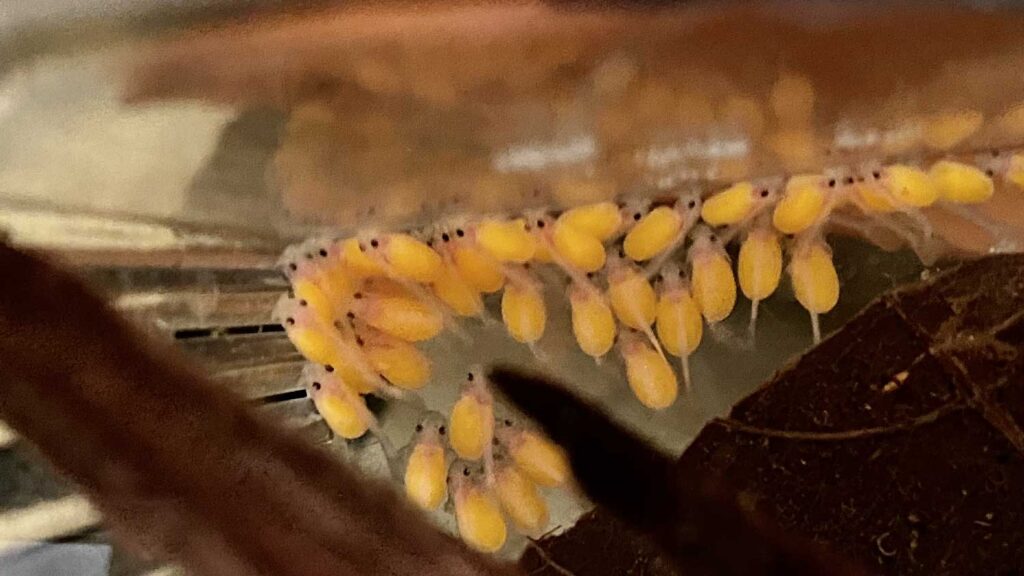
Breeding Queen Arabesque Pleco is a delicate and sometimes frustrating process. Breeding L260 Pleco can be done in aquariums when the conditions are right.
In order to breed these fish, you will need your L260 Pleco to be mature and at least 3-5 years old. Once you confirm you have at least one male and one female in your breeding group, you can start to condition your fish for breeding.
If you have more males in your tank, then make sure that each male has a cave available in the tank for them. The rule of thumb is to add at least one cave per each male if not more.
L260 Pleco are cave breeders which means they need caves to breed. The cave should be slightly bigger than the male’s body; but, small enough that he can trap the female inside.
For breeding purposes, the male looks around for a suitable cave to trap the female in. When the male finds a suitable cave, he will clean it out and wait for the female to arrive. The male will then trap the female and will not let her leave the cave until she lays eggs.
L260 Queen Arabesque Plecos lay about 25 – 50 eggs each time they breed.
Once eggs are laid, the male will let the female leave the cave, and then he will fertilize the eggs. It’s the male job to guard the eggs until they hatch. During this time, the male cleans the eggs and fans them so the eggs don’t go bad or get mold.
The eggs usually hatch 5 – 8 days after being laid.
After hatching, the fry usually stay at the back of the cave and feed on their egg sacks for the next few days. The male will keep the fry in the cave for another 10 – 12 days until they are fully developed and ready to leave.
Once the fry are strong enough, they will escape the cave and will attach to driftwood or glass in the aquarium. The fry usually stays together in a cluster in a single spot until they grow to half an inch in length.
Tank Mates
Queen Arabesque Pleco can live in community aquariums with fish that are around the same size. Male specimens are territorial and aggressive if a fish comes close to their hiding spot. To prevent aggressive behaviors we highly recommend you follow the “Tank Setup” section of this article. That said, the majority of South American fish will live happily with your L260 pleco and they will not bother each other.
The only limitations you will face in selecting tank mates for your Queen Arabesque Pleco are water parameters requirements and aggressiveness. Any fish that can not tolerate the water parameters required for this pleco is not an ideal tank mate. You should also avoid large or super aggressive fish as they will bully your pleco and might even try to eat it if the L260 Pleco can fit in their mouth. Below are some of the tank mate options for you to consider:

Conclusion
Now that you are familiar with the Queen Arabesque Pleco care, you can confidently look after your pet pleco. These fish are very calm and won’t bother their aquarium companions which makes them even easier to look after. For maximum growth and health, the L260 Pleco demands a warm, and clean tank. So long as you abide by the recommendations we made in this article, you should not face any problems.